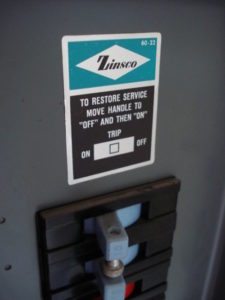With proper maintenance and care, your home’s main electrical panel can last for decades, however there is an important difference between a panel seemingly functioning properly, and actually protecting your home against overcurrent or electrical fault.
 A Zinsco panel is a good example of such an electrical panel. One of the most common faults of a Zinsco electrical panel is that the breakers don’t trip when there’s overcurrent or short circuits. Their breakers are made of a certain type of aluminum, which can melt and fuse to the bus bar. This means that the breaker won’t trip and can potentially cause an arc or even an electrical fire.
A Zinsco panel is a good example of such an electrical panel. One of the most common faults of a Zinsco electrical panel is that the breakers don’t trip when there’s overcurrent or short circuits. Their breakers are made of a certain type of aluminum, which can melt and fuse to the bus bar. This means that the breaker won’t trip and can potentially cause an arc or even an electrical fire.
What Is A Zinsco Panel?
Zinsco was established in 1943 and their panels were very common between the 1960s and 1970s. They were mostly installed in residential properties across North America. While many people have been upgrading their electrical panels, you can still find a Zinsco panel in some of the older homes today. Main and sub panels were manufactured by Zinsco and then sold to, and marketed by Sylvania. They are known fire hazards due to breakers failing and panel meltdowns.
Apart from them putting you and your household at risk, they’ve also become a nuisance, because most insurances won’t cover your house if you have one. The risks associated with these panels are both electrical fires and shock, with statistics showing that they fail to function properly almost 25% of the time. These panels would definitely not receive today’s UL listing.
How Do I Know If I Have A Zinsco Panel?
Open your panel and you should notice the Zinsco logo featured prominently.
Is It Safe To Keep a Zinsco Panel?
The short answer is NO. Zinsco panels are considered dangerous not just by electricians but also by industry experts. Apart from the breakers being manufactured with poor quality aluminum and the possibility of them melting, there are other issues with these panels that make them unsafe. For instance, the breakers may not connect properly to the bus bar. A loose connection can cause arcing, which produces high heat and can set fire to the entire panel. The bus bars tend to corrode easily as well.
The bottom line is that if you do have a Zinsco panel, the best step to take is to replace it. Whether you’re seeing signs of improper function or not, whether you’re being denied by your insurance company or not yet, these panels are not safe and should be replaced as soon as possible.
The original source article can be found on the Penna Electrical website.
